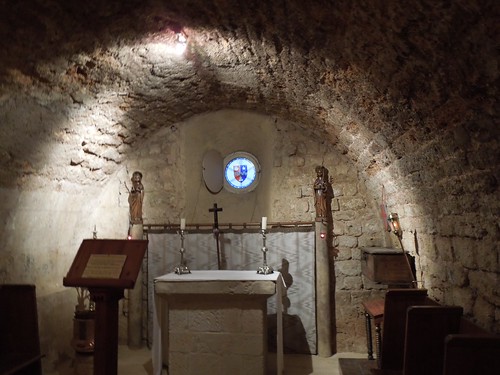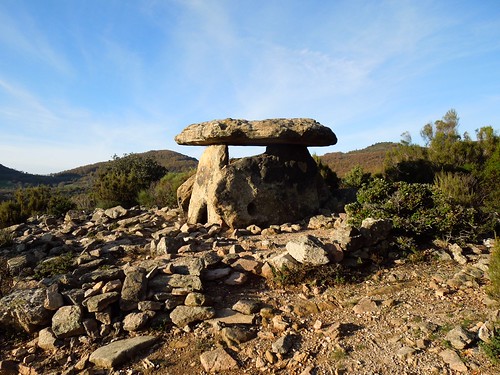In the Languedoc region there are many abbeys. Too many to possibly visit. However, we managed to seek out the properties that were very close to our town.
L'ABBAYE DE GELLONE
Guilhem, Count of Toulouse and grandson of Charles Martel , was one of the great paladins of his cousin Charlemagne. Guilhem's abbey is somber and beautiful. It has been stripped of much of its original decoration; it was sacked by the Protestants during the Wars of Religion, and its cloister was sold to the Rockefeller's who opened the Cloisters Museum , an extension of the Metropolitan Museum , in New York City in the early 20th century.
ABBAYE DE VALMAGNE
Medieval gardens and flowery fountain-clad cloister, this was one of southern France's richest abbeys from the 12th-15th centuries. It was founded in 1139 (when monks planted its extensive vineyards), and in 1257 its 6th - century Romanesque chapel was transformed into a classical Gothic church, inspired by northern France's great cathedrals. The abbey housed the Cistercian monks. Since 1789, when the last monks fled, the abbey has been used purely to make wine - of course we tasted it, and purchased some!
ABBAYE DE FONTCAUDE
In the valley of Fontcaude, there is a sacred source of water, which was the reason for the Canons to establish themselves in 1154. Romanesque, the abbey church, its cloister, and the 12th century bell foundry are worth a visit. The abbey was an important stop on the pilgrim's route of Santiago de Compostela. The Church, built in the last years of the 12th century and is the last Romanesque work in Languedoc.
ABBAYE DE FONTFROIDE
Isolated amid the wooded hills, Fontfroide was the most powerful Cistercian monastery in the south. It was founded by the Viscount of Narbonne in 1093 and adopted Cistercian rule after being visited by St Bernard in 1145. The monks were involved in many "political pies", and the abbots acted on the international stage.One of the abbots, Jacques Fournier was elected pope Benedice XII in Avignon in 1317. At the abbey's peak, its surrounding farms supported 300 monks. In 1348. the Black Death killed all but 20 monks. It recovered and in 1791 it knew a brief revival from 1858-1908.
The courtyards worthy of palaces, the large vaulted refectory, and the elegant late 12th-century cloister with its beautiful lace work of arches set in arches.The collages of older stained glass collected from churches in northern France after the First World War decorate the dormitories.
ABBAYE ST MICHEL DE GRANDMONT
This Abbey was located in the most beautiful setting in all of the Herault area. Pic Saint Loup - it is like entering another country. In the villages, the cliff edges of the "Loup" overlook the typical Mediterranean scrubland known as the 'garrigue", the vistas are magnificant.
The 12th entury priory is one of the best preserved of the 160 Grandmontine monasteries, a religious order founded by Etienne of Thiers. 1500 hermits occupied the 160 monasteries. Two monks remained until their deaths in 1785. It was the most strict and austere orders of the Middle Ages. No hierarchy,no archives, and no heating. They walked in their bare feet, worked and lived in perpetual silence, ate no meat, fasted regularly, and observed silent prayers. They were the first order to beg for food.
On the grounds were the prehistoric dolmens. They date from 2000BC. They are grouped in a mysterious way with other ritual megaliths and visigothic sarcophaguses.
ABBAYE OF SAINT HILAIRE
The first time the abbey is mentioned in writing was in 825, when as traditions have it, the body of St. Hilaire was buried here. The relics of St. Hilaire were transferred in presence of the count of Carcassonne and his wife in the year 970 when Benedict was abbot. Until the end of the 13th century the abbey was protected by the counts of Carcassonne. Tradition has it that in 1531 the monks of the abbey first made "Blanquette".
The sarcophagus of Saint Sernin may have once been an altar-piece. The sculptures in the marble illustrate the life of the saint who lived in Toulouse. The work is attributed to the Master of Cabestany. He is an anonymous sculptor who owes his name to the village in the Pyrenees Orientales.
THE CATHEDRAL OF MAGUELONE
It is located in an area of protected coastline with a broad variety of birds. The Cathedral is at the heart of an island of greenery, in a park, surrounded by vines, between sea and pond.
Roman style, of great purity, the Cathedral was the seat of the diocese for a thousand years from the 6th to the 16th century. The Maguelone was once a port in the Roman Empire. Charles Martel and the Saracens fought here, the clergy and bishop had to leave the place and return in the 11th century. In the 12th century, Maguelone was a land of welcome several times for popes.
The peacocks in the garden were brilliant, including several white peacocks.























































No comments:
Post a Comment